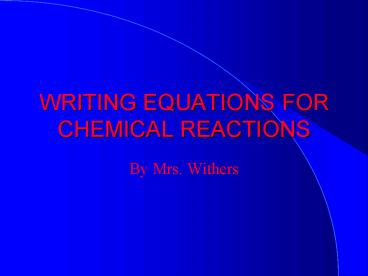WRITING EQUATIONS FOR CHEMICAL REACTIONS - PowerPoint PPT Presentation
1 / 14
Title:
WRITING EQUATIONS FOR CHEMICAL REACTIONS
Description:
WHAT IS A CHEMICAL EQUATION? A sentence with the ... numbers in front of a formula) are used to balance an equation. ... to balance an equation. ... – PowerPoint PPT presentation
Number of Views:308
Avg rating:3.0/5.0
Title: WRITING EQUATIONS FOR CHEMICAL REACTIONS
1
WRITING EQUATIONS FOR CHEMICAL REACTIONS
- By Mrs. Withers
2
WHAT ARE CHEMICAL REACTIONS?
- One or more beginning REACTANTS that combine to
form - One or more ending PRODUCTS
3
WHAT IS A CHEMICAL EQUATION?
- A sentence with the REACTANTS on the left,
- a YIELD (arrow) in the middle,
- and the PRODUCTS on the right.
- Separate two reactants or two products with a
PLUS ( ).
4
WHAT IS A SKELETON EQUATION?
- Skeleton equations do NOT indicate the relative
amounts of reactants and products.
Chemistry is EASY
5
RULES FOR WRITING SKELETON EQUATIONS
- Write correct formulas for reactants (place these
on the left). - Separate reactants with plus sign(s) ().
- Place a yield (arrow) after the last reactant.
- Write correct formulas for products (place these
on the right). - Separate products with plus sign(s) ().
- Write diatomic elements as the symbol with a
subscript of 2.(these elements cannot exist
alone.)
6
WHAT IS A BALANCED EQUATION?
- An equation with the same number of atoms of each
element on the reactant and the product side. - COEFFICIENTS (big numbers in front of a formula)
are used to balance an equation. - If possible count polyatomic ions as 1 unit
- DO NOT CHANGE SUBSCRIPTS to balance an equation.
- Make sure all coefficients are in the LOWEST
RATIO.
7
NAME FIVE TYPES OF CHEMICAL EQUATIONS.
- COMBINATION OR SYNTHESIS REACTION
- DECOMPOSITION REACTION
- SINGLE REPLACEMENT or SINGLE DISPLACEMENT
REACTION - DOUBLE REPLACEMENT or DOUBLE DISPLACEMENT
REACTION. - COMBUSTION REACTION
8
HOW CAN YOU RECOGNIZE A COMBINATION (SYNTHESIS)
REACTION?
- (WHAT FORM DOES THIS TYPE OF REACTION TAKE?)
- COMBINATION or SYNTHESIS REACTION
- 2 REACTANTS 1 PRODUCT
9
HOW CAN YOU RECOGNIZE A DECOMPOSITION REACTION?
- (WHAT FORM DOES THIS TYPE OF REACTION TAKE?)
- DECOMPOSITION REACTION
- 1 REACTANT 2 PRODUCTS
10
HOW CAN YOU RECOGNIZE A SINGLE REPLACEMENT
REACTION?
- (WHAT FORM DOES THIS TYPE OF REACTION TAKE?)
- SINGLE REPLACEMENT OR
- (SINGLE DISPLACEMENT REACTION)
- ELEMENT COMPOUND YIELDS ELEMENT COMPOUND
11
HOW CAN YOU RECOGNIZE A DOUBLE REPLACEMENT
REACTION?
- (WHAT FORM DOES THIS TYPE OF REACTION TAKE?)
- DOUBLE REPLACEMENT OR
- (DOUBLE DISPLACEMENT REACTION)
- COMPOUND COMPOUND YIELDS COMPOUND COMPOUND
12
HOW CAN YOU RECOGNIZE A COMBUSTION REACTION?
- (WHAT FORM DOES THIS TYPE OF REACTION TAKE?)
- COMBUSTION REACTION
- Hydrocarbon OXYGEN as reactants
- YIELD
- CARBON DIOXIDE WATER as products
13
NOW YOU NEED TO PRACTICE
- WRITE SOME EQUATIONS
- BALANCE THEM
- IDENTIFY THE TYPE OF REACTION
- DO THIS AGAIN AND AGAIN
14
AFTER YOU PRACTICE
- COLLECT YOUR A
- SMILE A MILE































